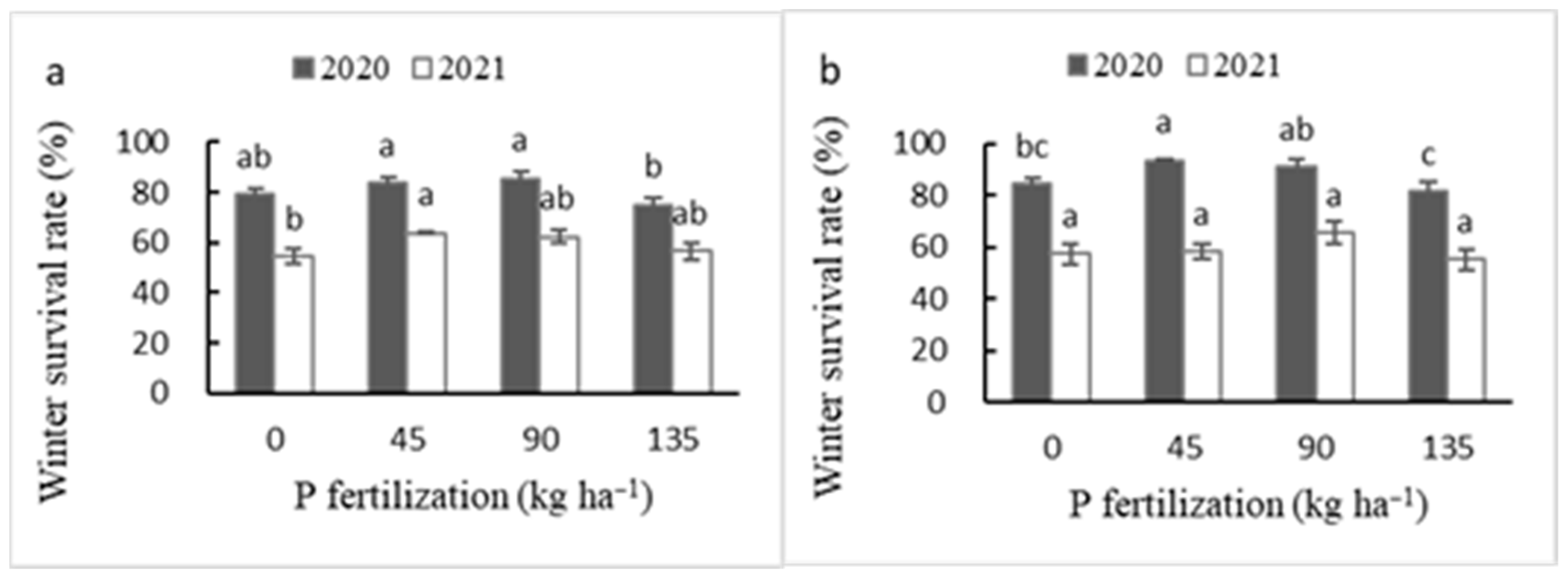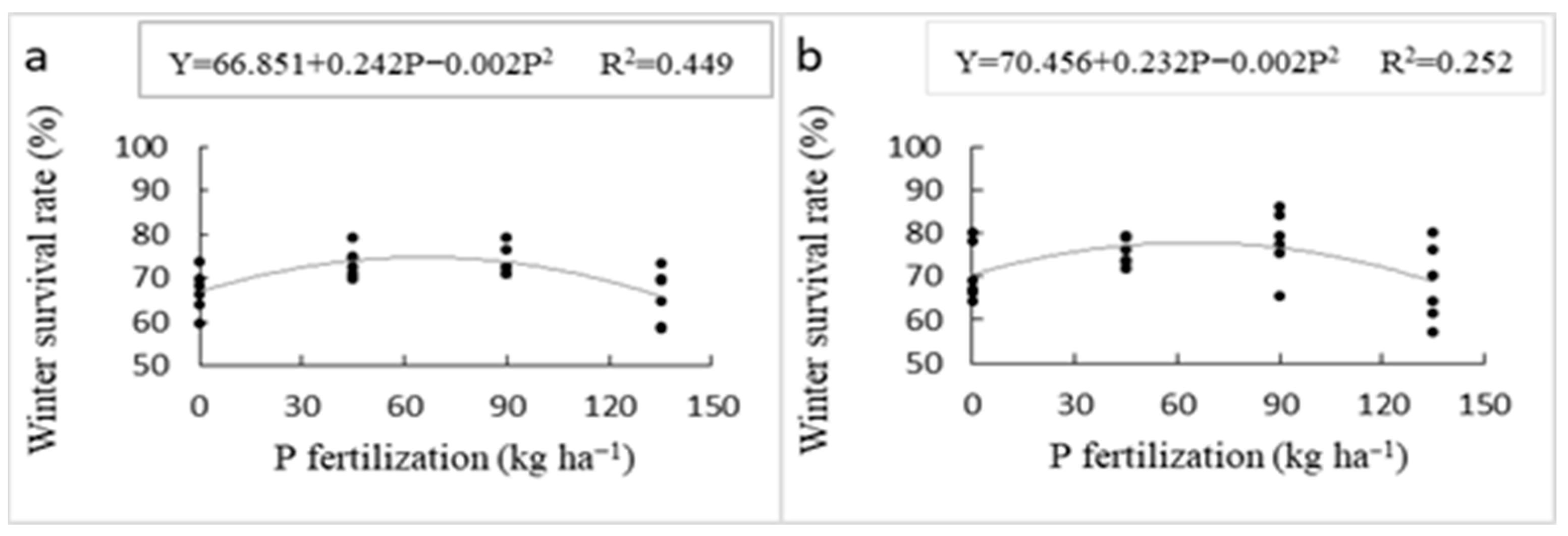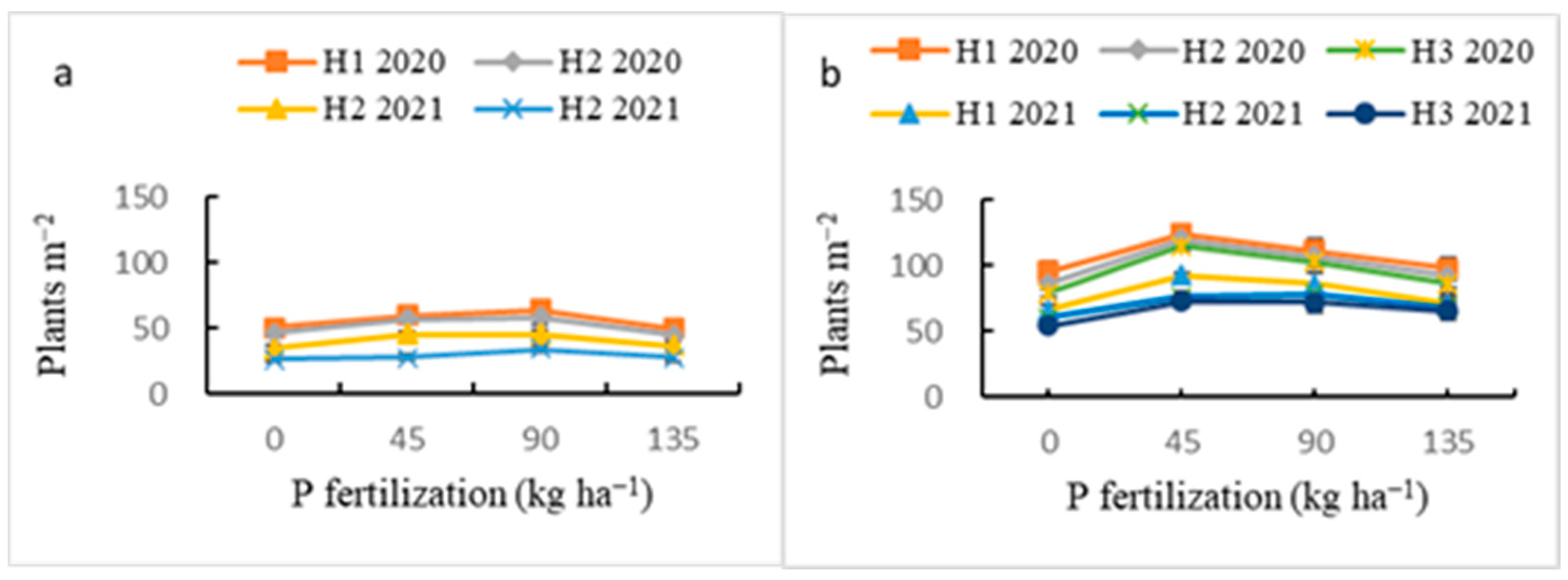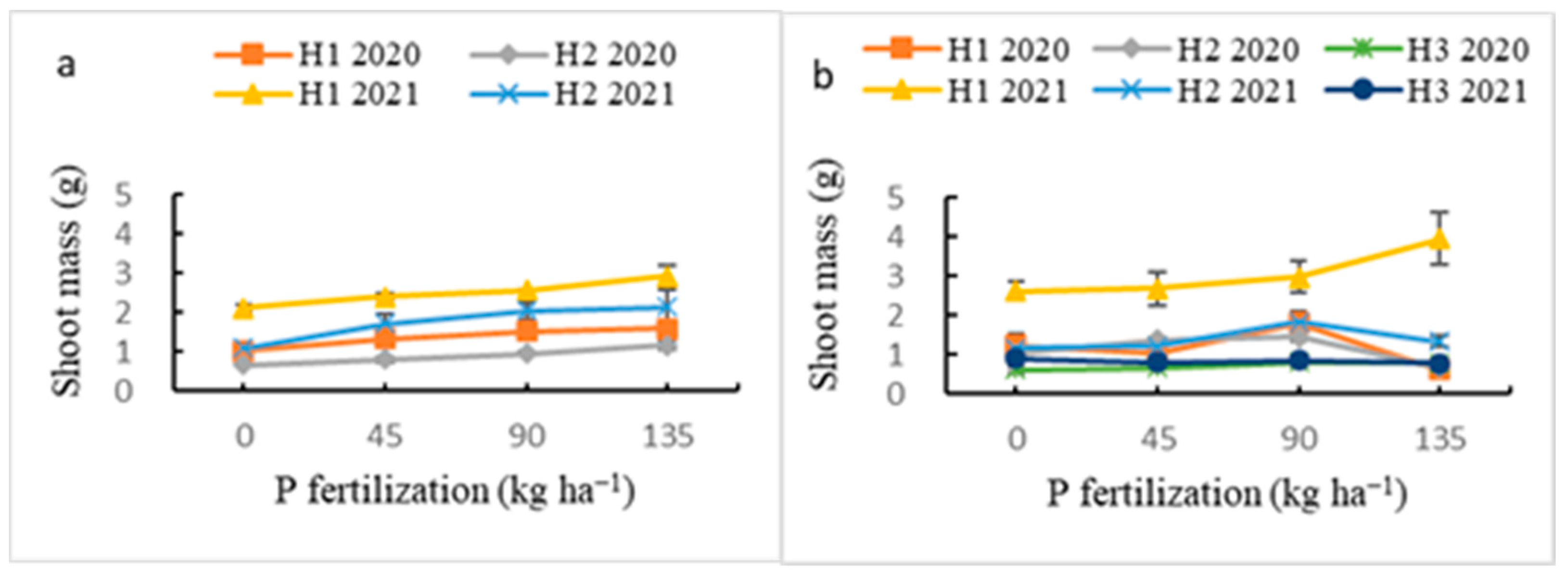Winter Survival, Yield and Yield Components of Alfalfa as Affected by Phosphorus Supply in Two Alkaline Soils
Abstract
1. Introduction
2. Materials and Methods
2.1. Growth Conditions
2.2. Plant Materials
2.3. Field Design
2.4. Investigation of Winter Survival Rate and Sampling
2.5. Statistical Analysis
3. Results
3.1. Main Effect of Soil Types and P fertilizer
3.2. Winter Survival Rate
3.3. Forage Yield
3.4. Yield Components
3.4.1. Plant Population Density
3.4.2. Shoots per Plant
3.4.3. Plant Height
3.4.4. Shoot Mass
3.5. Relative Importance of Yield Components
4. Discussion
4.1. Application of P Fertilizer Affects Winter Survival of Alfalfa
4.2. Application of P Fertilizer Affects Alfalfa Yield and Yield Components
5. Conclusions
Author Contributions
Funding
Data Availability Statement
Acknowledgments
Conflicts of Interest
References
- Radovic, J.; Sokolovic, D.; Markovic, J. Alfalfa-most important perennial forage legume in animal husbandry. Biotechnol. Anim. Husb. 2009, 25, 465–475. [Google Scholar] [CrossRef]
- Humphries, A.W.; Ovalle, C.; Hughes, S.; del Pozo, A.; Inostroza, L.; Barahona, V.; Yu, L.; Yerzhanova, S.; Rowe, T.; Hill, J.; et al. Characterization and pre-breeding of diverse alfalfa wild relatives originating from drought-stressed environments. Crop Sci. 2020, 61, 69–88. [Google Scholar] [CrossRef]
- Castonguay, Y.; Laberge, S.; Brummer, E.C.; Volenec, J.J. Alfalfa winter hardiness: A research retrospective and integrated perspective. Adv. Agric. 2006, 90, 203–265. [Google Scholar] [CrossRef]
- Xu, H.; Tong, Z.; He, F.; Li, X. Response of Alfalfa (Medicago Sativa L.) to Abrupt Chilling as Reflected by Changes in Freezing Tolerance and Soluble Sugars. Agronomy 2020, 10, 255. [Google Scholar] [CrossRef]
- Geng, H. Alfalfa of China; China Agricultural Press: Beijing, China, 1995. [Google Scholar]
- Vasileva, V.; Kostov, O. Effect of alfalfa grown for forage on soil fertility related to mineral and organic fertilization. Emir. J. Food Agric. 2015, 27, 678–686. [Google Scholar] [CrossRef]
- Berg, W.K.; Cunningham, S.M.; Brouder, S.M.; Joern, B.C.; Johnson, K.D.; Santini, J.B.; Volenec, J.J. The long-term impact of phosphorus and potassium fertilization on alfalfa yield and yield components. Crop Sci. 2007, 47, 2198–2209. [Google Scholar] [CrossRef]
- Richardson, A.E.; Lynch, J.P.; Ryan, P.R.; Delhaize, E.; Smith, F.A.; Smith, S.E.; Harvey, P.R.; Ryan, M.H.; Veneklaas, E.J.; Lambers, H.; et al. Plant and microbial strategies to improve the phosphorus efficiency of agriculture. Plant Soil 2011, 349, 121–156. [Google Scholar] [CrossRef]
- Jung, G.A.; Smith, D. Influence of soil potassium and phosphorus content on the cold resistance of alfalfa. Agron. J. 1959, 51, 585–587. [Google Scholar] [CrossRef]
- Ren, W.B.; Chen, L.B.; Guo, H.Q.; Zhu, X.U.; Xie, J.H. Progress in Winter Hardiness and Survival of Alfalfa. Chin. J. Grassl. 2008, 2, 104–108. [Google Scholar] [CrossRef]
- He, H.; Peng, Q.; Wang, X.; Fan, C.; Pang, J.; Lambers, H.; Zhang, X. Growth, morphological and physiological responses of alfal fa (Medicago sativa) to phosphorus supply in two alkaline soils. Plant Soil 2017, 416, 565–584. [Google Scholar] [CrossRef]
- Ventroni, L.M.; Volenec, J.J.; Cangiano, C.A. Fall dormancy and cutting frequency impact on alfalfa yield and yield components. Field Crop Res. 2010, 119, 252–259. [Google Scholar] [CrossRef]
- Jiang, H.; Shen, Y.; Zhai, G.; Liu, Z. Effect of phosphate fertilizer on the shoot growth and forage yield of Medicago Sativa L. Acta Agrestia Sin. 2009, 17, 588–592. [Google Scholar]
- Vu, D.T.; Tang, C.; Armstrong, R.D. Changes and availability of P fractions following 65years of P application to a calcareous soil in a Mediterranean climate. Plant Soil 2008, 304, 21–33. [Google Scholar] [CrossRef]
- Ulrich, A.E.; Malley, D.F.; Watts, P.D. Lake Winnipeg Basin: Advocacy, challenges and progress for sustainable phosphorus and eutrophication control. Sci. Total Environ. 2015, 542, 1030–1039. [Google Scholar] [CrossRef] [PubMed]
- Fixen, P.E.; Johnston, A.M. World fertilizer nutrient reserves: A view to the future. J. Sci. Food Agric. 2012, 92, 1001–1005. [Google Scholar] [CrossRef] [PubMed]
- Volenec, J.J.; Cherney, J.H.; Johnson, K.D. Yield components, plant morphology, and forage quality of alfalfa as influenced by plant population. Crop Sci. 1987, 27, 321–326. [Google Scholar] [CrossRef]
- Teixeira, E.I.; Moot, D.J.; Brown, H.E.; Fletcher, A.L. The dynamics of lucerne (Medicago Sativa L.) yield components in response to defoliation frequency. Eur. J. Agron. 2007, 26, 394–400. [Google Scholar] [CrossRef]
- Undersander, D.J.C.; Grau, D.; Cosgrove, J.D.; Martin, N. Alfalfa Stand Assessment: Is the Stand Good Enough to Keep; University of Wisconsin-Extension: Madison, WI, USA, 1998; pp. 3–6. [Google Scholar]
- Cowett, E.R.; Sprague, M.A. Factors affecting tillering in alfalfa1. Agron. J. 1962, 54, 937–940. [Google Scholar] [CrossRef]
- Feng, Y.Q.; Cao, Z.Z. Correlation analysis of yield components of Longdong black medic. J. Gansu Agric. Univ. 2006, 41, 76–78. [Google Scholar] [CrossRef]
- Wang, Y.; Zhang, J.; Yu, L.; Xu, Z.; Samac, D.A. Overwintering and Yield Responses of Two Late-Summer Seeded Alfalfa Cultivars to Phosphate Supply. Agronomy 2022, 12, 327. [Google Scholar] [CrossRef]
- Sanderson, M.A.; Jones, R.M. Stand dynamics and yield components of alfalfa as affected by phosphorus fertility. Agron. J. 1993, 85, 241–246. [Google Scholar] [CrossRef]
- Yang, M.; Shi, S.L. Study on grown diversity of alfalfa root. Grassl. Turf. 2016, 36, 21–27. [Google Scholar] [CrossRef]
- Li, R.; Volenec, J.J.; Joern, B.C.; Cunningham, S.M. Effects of phosphorus nutrition on carbohydrate and protein metabolism in alfalfa roots. J. Plant Nutr. 1998, 21, 459–474. [Google Scholar] [CrossRef]
- Deng, L.; Wang, K.B.; Li, J.P.; Shangguan, Z.P.; Sweeney, S. Carbon Storage Dynamics in Alfalfa (Medicago sativa) Fields in the Hilly-Gully Region of the Loess Plateau, China. Clean Soil Air Water 2014, 42, 1253–1262. [Google Scholar] [CrossRef]
- Malhi, S.S.; Arshad, M.A.; Gill, K.S.; McBeath, D.K. Response of alfalfa hay yield to phosphorus fertilization in two soils in central Alberta. Commun. Soil Sci. Plant Anal. 2008, 23, 717–724. [Google Scholar] [CrossRef]
- Sun, H.; Cao, Y.; Liu, L.; Wu, Y.; Yang, X.; Zhao, Y. Preliminary study on abundance-deficiency index of soil available P and appropriate phosphorus application rates for alfalfa in the North of China. Soil Fertil. Sci. China 2016, 3, 30–36. [Google Scholar] [CrossRef]
- Cunningham, S.M.; Gana, J.A.; Volenec, J.J.; Teuber, L.R. Winter Hardiness, Root Physiology, and Gene Expression in Successive Fall Dormancy Selections from ‘Mesilla’ and ‘CUF 101’ Alfalfa. Crop Sci. 2001, 41, 1091–1098. [Google Scholar] [CrossRef]
- Markus, D.K.; Battle, W.R. Soil and plant responses to long-term fertilization of alfalfa (Medicago Sativa L.). Agron. J. 1965, 1, 613–616. [Google Scholar] [CrossRef]
- Powell, R.D. Alfalfa Fertilization; University of Wisconsin-Extension: Madison, WI, USA, 1972; p. A2448. [Google Scholar]
- Gross, H.D.; Wilsie, C.P.; Pesek, J. Some responses of alfalfa varieties to fertilization and cutting treatments. Agron. J. 1958, 50, 161–164. [Google Scholar] [CrossRef]
- Mays, D.A. Effect of fertilization on winterhardiness of forages. In Forage Fertilizer; Kresge, C.B., Ed.; Tennessee Valley Authority Pullman: Washington, DC, USA, 1974. [Google Scholar]
- Abu Qamar, S.F.; Cunningham, S.M.; Volenec, J.J. Phosphate Nutrition and Defoliation Effects on Growth and Root Physiology of Alfalfa. J. Plant Nutr. 2006, 29, 1387–1403. [Google Scholar] [CrossRef]
- Elser, J.J.; Bracken, M.E.S.; Cleland, E.E.; Gruner, D.S.; Harpole, W.S.; Hillebrand, H.; Ngai, J.T.; Seabloom, E.W.; Shurin, J.B.; Smith, J.E. Global analysis of nitrogen and phosphorus limitation of primary producers in freshwater, marine and terrestrial ecosystems. Ecol. Lett. 2007, 10, 1135–1142. [Google Scholar] [CrossRef]
- Liu, H.X.; Li, N.; Sheng, J.D.; Yan-Bo, F.U.; Wang, X.D. Effects of Phosphorus Fertilizer on the Growth and Seed Yield of Alfalfa. Acta Agrestia Sin. 2013, 21, 571–575. [Google Scholar]
- Mays, D.A.; Griffith, W.K. Satisfying the Nutritional Requirements of Established Legumes. Forage Fertil. 1974, 147–169. [Google Scholar] [CrossRef]
- Berg, W.K.; Cunningham, S.M.; Brouder, S.M.; Joern, B.C.; Johnson, K.D.; Santini, J.; Volenec, J.J. Influence of phosphorus and potassium on alfalfa yield and yield components. Crop Sci. 2005, 45, 297–304. [Google Scholar] [CrossRef]
- Hanson, R.G.; Macgregor, J.M. Soil and alfalfa plant characteristics as affected by a decade of fertilization. Agron. J. 1966, 58, 3–5. [Google Scholar] [CrossRef]
- Wen, Y. Effect of Phosphorus and Potassium Nutrition on Yield and Quality of Alfalfa (Medicago Sativa L.) and Related Mechanisms; Chinese Academy of Agricultural Sciences: Beijing, China, 2005. [Google Scholar]
- Lemaire, G.; Onillon, B.; Gosse, G.; Chartier, M.; Allirand, J.M. Nitrogen distribution within a lucerne canopy during regrowth: Relation with light distribution. Ann. Bot. 1991, 68, 483–488. [Google Scholar] [CrossRef]
- Wang, Y.H.; Li, D.F.; Qi, S.L.; Wang, C.Z.; Li, P.F. Effects of seeding rate and variety on branch number and plant height of alfalfa. Acta Pratacult. Sin. 2017, 26, 183. [Google Scholar]
- Suzuki, M. Effects of stand age on agronomic, morphological and chemical characteristics of alfalfa. Can. J. Plant 1991, 71, 445–452. [Google Scholar] [CrossRef]
- Sun, Y.M.; Liu, X.S.; Zhang, Q.B.; Wu, H.; Ma, C.H. Effects of phosphorus application on hay yield and phosphorus contents of alfalfa under drip irrigation. Acta Pratacult. Sin. 2019, 28, 154–163. [Google Scholar] [CrossRef]
- Singh, Y.; Winch, J.E. Morphological development of two alfalfa cultivars under various harvesting schedules. Can. J. Plant Sci. 1974, 54, 79–87. [Google Scholar] [CrossRef]







| Site | Soil Type | Organic C (g kg−1) | Total N (g kg−1) | Available P (mg kg−1) | Available K (mg kg−1) | Salt (g kg−1) | pH |
|---|---|---|---|---|---|---|---|
| Siziwang | Aeolian sandy soil | 30.5 | 1.71 | 21.4 | 306.5 | 1.43 | 8.6 |
| Tuzuo | Silt loam soil | 7.30 | 1.09 | 13.3 | 384.0 | 1.39 | 8.5 |
| Month | Siziwang County | Tuzuo County | ||||||||||
|---|---|---|---|---|---|---|---|---|---|---|---|---|
| Temperature (°C) | Precipitation (mm) | Temperature (°C) | Precipitation (mm) | |||||||||
| 2019 | 2020 | 2021 | 2019 | 2020 | 2021 | 2019 | 2020 | 2021 | 2019 | 2020 | 2021 | |
| Jan. | −11.9 | −11.4 | −11.9 | 0 | 4.8 | 0 | −9.8 | −8.5 | −9.5 | 0 | 3.3 | 5.3 |
| Feb. | −10.8 | −5.8 | −4.1 | 4.4 | 0 | 2.0 | −8.0 | −4 | 0 | 6.3 | 14.5 | 0.1 |
| Mar. | −0.2 | 0.1 | 1.9 | 8.9 | 15.1 | 9.2 | 2.0 | 3 | 4.5 | 3.7 | 25.1 | 6.7 |
| Apr. | 8.5 | 6.5 | 7.1 | 29.5 | 0.2 | 0 | 10.9 | 8.5 | 8.5 | 17.2 | 3.7 | 0.1 |
| May | 13.6 | 14.3 | 12.7 | 31.4 | 19.6 | 36.4 | 15.5 | 16 | 15 | 9.8 | 29.2 | 23.5 |
| June | 19.2 | 19.4 | 18.5 | 48.9 | 51 | 62.7 | 21.4 | 20 | 20.5 | 47.9 | 73.2 | 19.4 |
| July | 19.9 | 19.6 | 20.8 | 127.6 | 176.8 | 81.9 | 21.4 | 21 | 23 | 102.3 | 89.1 | 104.7 |
| Aug. | 18.2 | 18.6 | 17.6 | 82.5 | 103.1 | 67.3 | 19.8 | 20 | 20 | 91.3 | 68.9 | 171.6 |
| Sept. | 14.9 | 12.7 | 15.1 | 62.5 | 9.9 | 30.6 | 16.8 | 14.5 | 17.5 | 101.4 | 25 | 54.2 |
| Oct. | 6.3 | 4.4 | 4.7 | 11.3 | 14.6 | 13.7 | 8.0 | 5.5 | 7.5 | 18.3 | 23 | 10.2 |
| Nov. | −2.0 | −3.6 | −3.4 | 4.7 | 18.8 | 18.7 | −0.5 | −0.5 | −1 | 7.1 | 0.1 | 5.7 |
| Dec. | −9.9 | −13.7 | −8.6 | 1.6 | 0 | 0 | −9.7 | −11 | −6.5 | 6.8 | 0.1 | 0.3 |
| Source | df+ | Yield | Plants m−2 | Shoots Plant−1 | Height | Shoot Mass | Annual Yield | Winter Survival |
|---|---|---|---|---|---|---|---|---|
| Site | 1 | *** | *** | *** | *** | *** | ** | * |
| Harvest | 2 | *** | *** | *** | *** | *** | ||
| Year | 1 | *** | *** | *** | ns | *** | *** | *** |
| Cultivar | 1 | *** | *** | *** | ns | ns | *** | *** |
| P | 3 | *** | *** | *** | *** | *** | *** | *** |
| Site × harvest | 1 | *** | ns | ns | *** | ns | ||
| Site × year | 1 | *** | *** | ns | *** | *** | *** | ** |
| Site × cultivar | 1 | ns | *** | ns | *** | * | ns | ns |
| Site × P | 3 | *** | *** | ns | *** | *** | ** | ns |
| Harvest × year | 2 | *** | ns | *** | * | * | ||
| Harvest × cultivar | 2 | ns | * | *** | ns | ** | ||
| Harvest × P | 6 | ** | ns | ns | *** | *** | ||
| Year × cultivar | 1 | ns | ns | * | ns | * | ns | ns |
| Year × P | 3 | * | ** | ns | ** | *** | ns | ns |
| Cultivar × P | 3 | ns | *** | * | ns | ns | ns | ** |
| Site × harvest × year | 1 | ** | ns | *** | ns | *** | ||
| Site × harvest × cultivar | 1 | ns | ns | ns | ns | *** | ||
| Site × harvest × P | 3 | ns | ns | ns | ns | ns | ||
| Site × year × cultivar | 1 | ns | ns | ns | ns | ns | ns | ns |
| Site × year × P | 3 | *** | ns | ns | *** | *** | *** | ns |
| Site × cultivar × P | 3 | ** | ** | ns | ns | ns | * | ns |
| Harvest × year × cultivar | 2 | ns | ns | * | ns | ** | ||
| Harvest × year × P | 6 | * | ns | ns | *** | *** | ||
| Harvest × cultivar × P | 6 | ns | ns | ** | ns | ns | ||
| Year × cultivar × P | 3 | ns | ns | ns | ns | ** | ns | ns |
| Site × harvest × year × cultivar | 1 | ns | ns | ns | ns | * | ||
| Site × harvest × year × P | 3 | ns | ns | ns | ns | * | ||
| Site × harvest × cultivar × P | 3 | ns | ns | ns | ns | * | ||
| Site × year × cultivar × P | 3 | ns | ns | ns | ns | ns | ns | ns |
| Harvest × year × cultivar × P | 6 | ns | ns | ns | ns | * | ||
| Site × harvest × year × cultivar × P | 3 | ns | ns | ns | * | *** |
| Site | Year | Harvest | Levels of Applied P (kg ha−1) | |||
|---|---|---|---|---|---|---|
| 0 | 45 | 90 | 135 | |||
| Siziwang | 2020 | H1 | 3859.8 ± 367.6 b | 5508.8 ± 851.9 ab | 5809.2 ± 448.6 a | 5943.8 ± 598.3 a |
| H2 | 2038.7 ± 304.1 b | 2648.1 ± 264.9 b | 3242.3 ± 623.9 ab | 4348.4 ± 487.9 a | ||
| Annual | 5898.5 ± 564.2 b | 8206.9 ± 927.2 ab | 9101.5 ± 1006.1 a | 10,292.2 ± 934.1 a | ||
| 2021 | H1 | 3882.5 ± 387.9 a | 4638.6 ± 401.5 a | 4537.5 ± 190.2 a | 4019.6 ± 210.3 a | |
| H2 | 2142.6 ± 200.9 b | 2687.1 ± 245.8 b | 3849.4 ± 397.3 a | 2873.2 ± 405.3 b | ||
| Annual | 6025.1 ± 516.3 b | 7325.8 ± 487.3 ab | 8386.8 ± 487.9 a | 6892.8 ± 567.5 ab | ||
| Tuzuo | 2020 | H1 | 3078.0 ± 164.8 c | 4999.1 ± 354.1 b | 6562.2 ± 474.2 a | 2437.0 ± 161.5 c |
| H2 | 2321.2 ± 119.4 c | 3292.2 ± 327.5 b | 4064.4 ± 258.7 a | 2072.1 ± 154.4 c | ||
| H3 | 1625.3 ± 93.9 c | 2143.1 ± 152.5 b | 2709.1 ± 131.8 a | 1809.2 ± 227.1 bc | ||
| Annual | 7024.5 ± 313.6 c | 10,434.4 ± 645.5 b | 13,335.6 ± 320.8 a | 6318.3 ± 392.8 c | ||
| 2021 | H1 | 3569.7 ± 563.0 c | 4498.7 ± 627.3 bc | 6331.7 ± 709.9 a | 5543.9 ± 320.8 ab | |
| H2 | 3375.8 ± 296.1 b | 5327.0 ± 487.1 a | 4952.0 ± 293.1 a | 5535.7 ± 225.8 a | ||
| H3 | 2339.6 ± 214.3 ab | 2111.9 ± 130.9 b | 3003.4 ± 133.9 a | 2624.4 ± 379.9 ab | ||
| Annual | 9285.1 ± 866.6 b | 11,937.6 ± 977.5 a | 14,287.2 ± 846.2 a | 13,704.0 ± 697.1 a | ||
| Site | Harvest | 2020 | 2021 | ||||
|---|---|---|---|---|---|---|---|
| Plants m−2 | R2 | p Value | Plants m−2 | R2 | p Value | ||
| Siziwang | H1 | y = 2875 + 42.76x | 0.087 | 0.163 | y = 3948 + 7.83x | 0.006 | 0.720 |
| H2 | y = 2879 + 4.14x | 0.001 | 0.880 | y = 7816 − 401.7x + 7.66x2 | 0.232 | 0.063 | |
| Tuzzuo | H1 | y = 1038 + 30.125x | 0.112 | 0.110 | y = 14,351 − 250.92x + 1.606x2 | 0.070 | 0.467 |
| H2 | y = 601 + 23.041x | 0.222 | 0.020 | y = 3266 + 21.53x | 0.060 | 0.248 | |
| H3 | y = 360 + 17.849x | 0.380 | 0.001 | y = 4846 − 61.041x + 0.374x2 | 0.060 | 0.552 | |
| Site | Harvest | 2020 | 2021 | ||||
|---|---|---|---|---|---|---|---|
| Shoots Plant−1 | R2 | p Value | Shoots Plant−1 | R2 | p Value | ||
| Siziwang | H1 | y = 2955 + 266.348x | 0.070 | 0.213 | y = 2030 + 224.385x | 0.170 | 0.045 |
| H2 | y = −503 + 275.734x | 0.231 | 0.017 | y = 1462 + 112.16x | 0.041 | 0.345 | |
| Tuzzuo | H1 | y = 3388 + 94.746x | 0.031 | 0.411 | y = 3811 + 142.593x | 0.019 | 0.519 |
| H2 | y = −1556 + 1085x − 61.508x2 | 0.219 | 0.075 | y = 3148 + 125.969x | 0.064 | 0.233 | |
| H3 | y = 10.632 + 0.0002x | 0.001 | 0.883 | y = −524 + 298.51x − 6.312x2 | 0.274 | 0.035 | |
| Site | Harvest | 2020 | 2021 | ||||
|---|---|---|---|---|---|---|---|
| Plant Height | R2 | p Value | Plant Height | R2 | p Value | ||
| Siziwang | H1 | y = −804 + 94.459x | 0.277 | 0.008 | y = −21,333 + 966.187x − 9.014x2 | 0.233 | 0.061 |
| H2 | y = −1830 + 94.493x | 0.354 | 0.002 | y = −30,635 + 1514.672x − 16.894x2 | 0.221 | 0.072 | |
| Tuzzuo | H1 | y = −1656 + 92.598x | 0.497 | 0.000 | y = −37,232 + 1289.212x − 9.692x2 | 0.277 | 0.033 |
| H2 | y = −1027 + 32.13x | 0.256 | 0.012 | y = 3264 + 21.577x | 0.023 | 0.483 | |
| H3 | y = 575 + 40.027x | 0.184 | 0.036 | y = −9035 − 311.448x + 3.618x2 | 0.348 | 0.011 | |
| Site | Harvest | 2020 | 2021 | ||||
|---|---|---|---|---|---|---|---|
| Shoot Mass | R2 | p Value | Shoot Mass | R2 | p Value | ||
| Siziwang | H1 | y = −3378 + 1378.802x | 0.092 | 0.151 | y = −4078 + 293.026x − 83.432x2 | 0.011 | 0.892 |
| H2 | y = −92 + 3305.794x | 0.442 | 0.000 | y = −1799 + 1283.273x − 317.444x2 | 0.068 | 0.478 | |
| Tuzzuo | H1 | y = −2450 + 1533.601x | 0.241 | 0.015 | y = −2850 + 697.666x | 0.244 | 0.014 |
| H2 | y = −1381 + 1379.479x | 0.397 | 0.001 | y = 3899 + 649.409x | 0.100 | 0.133 | |
| H3 | y = 1664 + 566.934x | 0.032 | 0.403 | y = −1521 + 1192.632x | 0.163 | 0.051 | |
| Siziwang | H1 a | H2 | Year 2020 b | Year 2021 |
|---|---|---|---|---|
| Plants m−2 → yield c | --- | --- | --- | --- |
| Shoots plant−1 → yield c | 0.38 | --- | --- | --- |
| Plant height → yield c | 0.65 | 0.46 | 0.58 | 0.55 |
| Shoot mass → yield c | --- | --- | 0.44 | 0.45 |
| Tuzuo | H1 a | H2 | H3 | Year 2020 b | Year 2021 |
|---|---|---|---|---|---|
| Plants m−2 → yieldc | --- | --- | --- | --- | --- |
| Shoots plant−1 → yield c | --- | 0.47 | --- | --- | --- |
| Plant height → yield c | 0.33 | 0.48 | 0.52 | 0.56 | 0.36 |
| Shoot mass → yield c | 0.29 | --- | --- | 0.24 | 0.43 |
Disclaimer/Publisher’s Note: The statements, opinions and data contained in all publications are solely those of the individual author(s) and contributor(s) and not of MDPI and/or the editor(s). MDPI and/or the editor(s) disclaim responsibility for any injury to people or property resulting from any ideas, methods, instructions or products referred to in the content. |
© 2023 by the authors. Licensee MDPI, Basel, Switzerland. This article is an open access article distributed under the terms and conditions of the Creative Commons Attribution (CC BY) license (https://creativecommons.org/licenses/by/4.0/).
Share and Cite
Wang, Y.; Sun, Z.; Wang, Q.; Xie, J.; Yu, L. Winter Survival, Yield and Yield Components of Alfalfa as Affected by Phosphorus Supply in Two Alkaline Soils. Agronomy 2023, 13, 1565. https://doi.org/10.3390/agronomy13061565
Wang Y, Sun Z, Wang Q, Xie J, Yu L. Winter Survival, Yield and Yield Components of Alfalfa as Affected by Phosphorus Supply in Two Alkaline Soils. Agronomy. 2023; 13(6):1565. https://doi.org/10.3390/agronomy13061565
Chicago/Turabian StyleWang, Yuntao, Zhen Sun, Qiqi Wang, Jihong Xie, and Linqing Yu. 2023. "Winter Survival, Yield and Yield Components of Alfalfa as Affected by Phosphorus Supply in Two Alkaline Soils" Agronomy 13, no. 6: 1565. https://doi.org/10.3390/agronomy13061565
APA StyleWang, Y., Sun, Z., Wang, Q., Xie, J., & Yu, L. (2023). Winter Survival, Yield and Yield Components of Alfalfa as Affected by Phosphorus Supply in Two Alkaline Soils. Agronomy, 13(6), 1565. https://doi.org/10.3390/agronomy13061565






